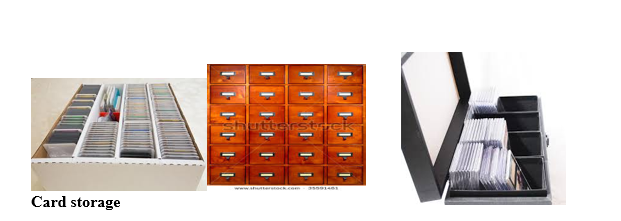The management of records in both small / large organisation involves large investment in personnel, supplies, equipment and office floor space.
Record storage refers to the equipment and systems used to file records during their useful lifetime in an organisation. Because the purchase of equipment involves spending money a conscious effort must be made to determine which record to retain and for how long. For those earmarked for storage a systematic record storage system should be developed so that records can be safely stored and maintained. The stored records must be utilized or removed for reference purpose or updating. Hence records must be stored in a manner that will hasten their identification and retrieval. There are various records storage and retrieval systems for the various types of records such as:
Paper Based Records
These are records where information is captured and stored on paper/card stock. Referred to as hard copy. They include correspondences such as letters, memos, reports, business forms such as invoices, purchase orders, vouchers, computer print outs and cards such as index cards, accounts ledger cards, punched cards.
Electronic Based Records
Encompass information/data recorded in digital form on a magnetic medium e.g. computer tape, floppy disk, magnetic card, hard disk etc. such data is only retrieved by a word processor, a computer or computer assisted retrieval system.
Microform Based Records
Data/documents whose images have been photographed in highly reduced form and stored in a microfilm e.g. microfiche and microfilm. The purchase of storage equipment constitutes a huge investment in any company. Various factors may be considered when planning to acquire to ensure that specific storage needs are met.
Factors to consider in acquiring storage equipment
- Forms of Records Stored
An understanding of what needs to be filled is essential. An understanding of the company types of records and their forms will help in determining the storage equipment to acquire e.g. paper based- are they all correspondences, business forms, reports, maps, cards etc
- Use of stored records
Consider how records are used, are they frequently referred to for reference and updating? If above is the case records/files must be stored in such a manner that they are readily accessible for filling and refilling.
- Personnel
Consider who must use records storage equipment. Are the personnel compliant with the equipment, are they intimidated or is the equipment user friendly.
- Consider space available and its cost
Will equipment consume too much space- consist height, width, depth aisle space requirements for the type of storage equipment in relation to available space.
- Protection and Security
Consider the degree of protection and security accorded to records by the equipment, consider the nature of records at hand and determine whether the equipment will provide required security for confidential records. Will privacy of classified files be maintained /assured? Will it protect records from natural disaster/human elements?
- Length of Storage time
Length of retention period will determine type of storage equipment. The established records retention schedule will provide guidelines. Records that must be retained for long period must be stored in equipment that will prolong their lifespan.
- Costs and Productivity
Consider money allocated for acquiring the equipment. Go for equipment that is reasonably cheap but functional. Consider efficiency, reliability and maintenance cost of a record. Consider if the equipment will enhance productivity.
Types of storage equipment
Types of storage equipment can either be manual, or electronic
- Standard Vertical file cabinet
This is commonly used to store paper based records, they are today made of steel, available in 2-6 drawers, most ideal is the 5 drawer cabinet. It provides easy access to records because of its floor height which allows office personnel to use all drawers without an auxiliary equipment. It has approximately 25% more space capacity than the commonly used four drawer model. It provides better air space utilization than the 2-4 models, the 2 drawer unit may be used for desks or tables top storage. The 3 drawer unit may be used alongside desk to provide convenient and accessible record storage and ready access to frequently referenced information.
The 6 drawer unit may require the use of ladder/stepstool for personnel to access the top drawer hence their height hinders their popularity for active record hence its convenient for inactive record storage.
The 5 drawer cabinet is a common sight in office and registries, it is popular for transaction and filing. Ease of storage and retrieval of records makes this equipment very popular and active storage. Records are dropped/inserted into their folders within their drawers where necessarily removing the folders from their position in the drawer.
Equipment is ideal when records are referenced only when they need to be (re) filed when only few people must use/have access to records. Equipment also provide adequate security for confidential/security classified records, equipment is durable and portable. All drawers may be used to store correspondences or top drawer(s) may be designated for storing special paper records such as cards, checks or standardized business forms.
Disadvantages
- Occupies a lot of space
- Depth and length of drawer when fully opened must be provided for as well as space for the isle
- Maintenance cost is high because of more space to be cleaned
- Only one file worker at a time can gain access to the files thus creating a bottleneck if several people would want to obtain information from the files at the same time
- Storage spaces are not expandable to meet storage needs.
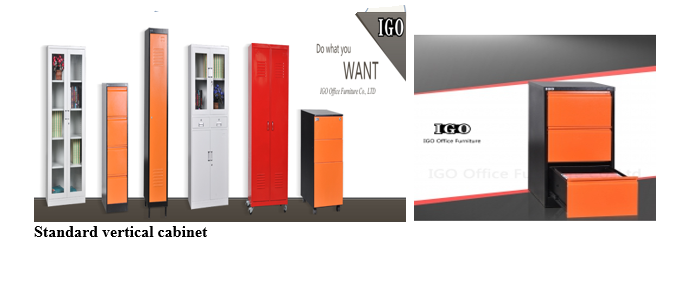
- Lateral File Cabinets
They are lengthwise units whose shelves or drawers open broad wise, can be available with 2-6 drawers. It provides quick and easy access to record because all records are visible when drawers are opened or a shelf pulled out from the cabinet. The drawers are shallow and hence less effort is expended in opening drawers and accessioning records by personnel. Records can restored lengthwise facing one side of the drawer/shelf or facing the front.
The drawer might be divided into section 3 and records stored horizontally. A six drawer lateral cabinet occupies less floor space (40% less floor space than a standard four drawer vertical cabinet) in addition lateral file units require only six (6) inches of aisle space. Storage capacity is more than the 4 drawer vertical cabinet.
Advantages of Lateral File Units
- Occupies less floor space
- Storage capacity is greater than that of vertical file cabinet
- Provides economical and efficient records storage and retrieval
- Various sizes and forms of records may be stored in the same unit (flexible)
- Lateral file units that may have retractable drop-lid doors protect records from dust and fire when not in use.
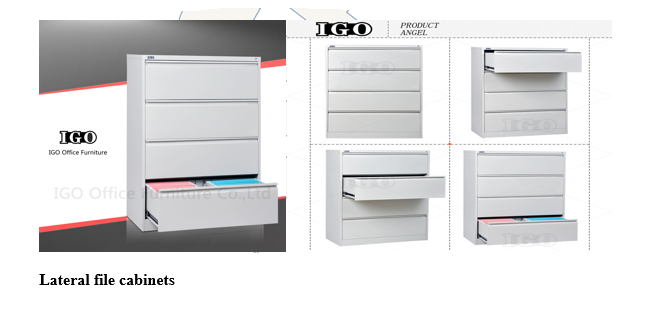
- Open Shelf Unit
Records stored in traditional bookshelf fashion. The records are exposed for ease in referencing because records are visible. They provide easy access to records since they are no drawers to open. It is on record that these units allow 20-40% faster filing, refilling and retrieving than in file drawer cabinets. They occupy less floor space (50% less floor space than traditional file drawer cabinets) their maintenance cost is less expensive
The facility is expandable
Registry personnel need not be fatigued since they do not have to move around as much, very ideal for companies where records are referred frequently.
Disadvantages
- Individual file folders must be removed from the shelves for referencing/refilling
- Depending on height, auxiliary equipment (ladder) may be required
- Not ideal for storing security classified records
- Difficult in preventing unauthorized access to stored records
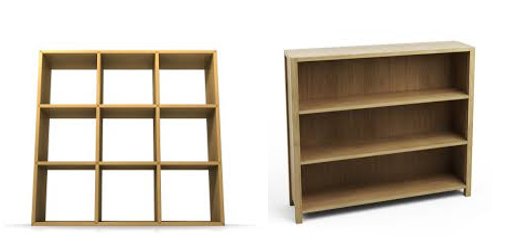
Storage of Oversized Records
Storage of Oversized Records requires specialized equipment e.g. drawing plans, maps, blueprints etc.
- Oversized file drawer cabinet
Are similar to those used for correspondences (business forms) only much larger and can extend from floor to ceiling. Such are used in vertical filing.
There are also those available in a large number of wide shallow drawers so that records like drawings, maps and photos can be stored face up and flat.
An index of records stored in the file unit can be affixed to the inside of the lid of the file unit.
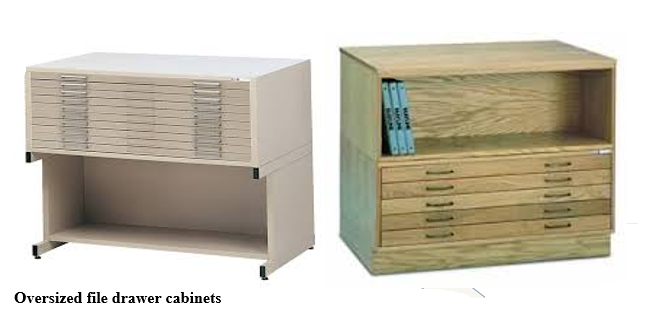
- Suspension Files
Consist of wall hung or free standing unit of open shelves/cabinet. Documents within folders are suspended on the rods extending from one end to the other. The folders are themselves filed in suspension folders. Large and bulky documents can be stored in suspension files e.g. topographical maps. Such units are ideal for files needing reference by many people.
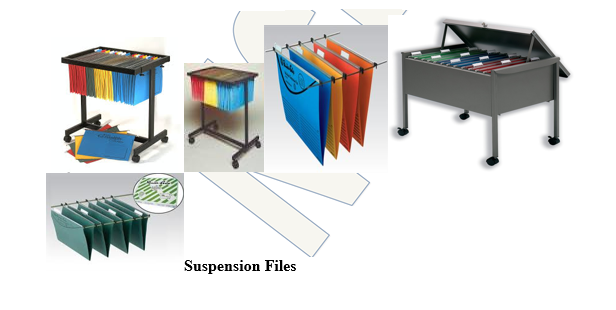
- Rolled Plan Files
Provide convenient and relatively compact storage for large documents such as plans, drawings and maps. Such are rolled and placed in pigeonhole storage cubicles/shelves. The contents can be identified by a label at the edge of the tube. An index on the cabinet door can identify the documents stored in each cubicle.
Disadvantages
- Records are easily torn/creased if they must be rolled and unrolled frequently
- Unrolling/rolling of plant may make it curl making it difficult to read
- Rolled plans are difficult to carry/transport
- Plans and other large documents are available in many sizes making it difficult to standardize cabinets or the shelving unit.
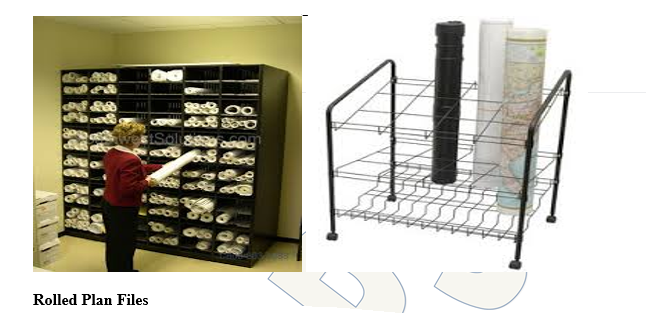
- Card Storage
Cards Storage can either be vertically or horizontally (Visible)
Vertical Cards Files: stored upright in the card filing equipment because cards are generally heavier than correspondences and also because each card contains essentially one item of information, cards are filed directly into their storage facilities without file folders. Card storage for vertical files include drawer cabinets are made for cards for various sizes.
Card file boxes are also available for all standard sizes. These boxes are also available for all standard card sizes and they may be used for temporary or permanent storage of cards and files. Card boxes can be available in plastic, wood and metal, such boxes are ideal for a small volume of cards that must be maintained; where several people must reference the cards frequently or where cards must be moved from one work station to another. The card file boxes can be situated for cross reference purposes where notations can be made on the cards to refer to specific sources of records for more detailed information.
Card trays: can be acquired when more permanent storage is desired, such portable trays can slide in and out of specially equipped desks or file equipment, trays can also be stored in a desk drawer or on top of a desk or cabinet.
Rotary Wheel file: Primarily used to store cards needed for quick reference, such equipment are usually small desktop revolving wheels in which business calling cards/index cards are placed. in this equipment the stock of cards on the wheel is turned until the desired card is located, such equipment provides quick access to customers names and address, telephone numbers or other commonly needed items of information. It takes up little space on desk/counter top. Are easy to update and expand.
